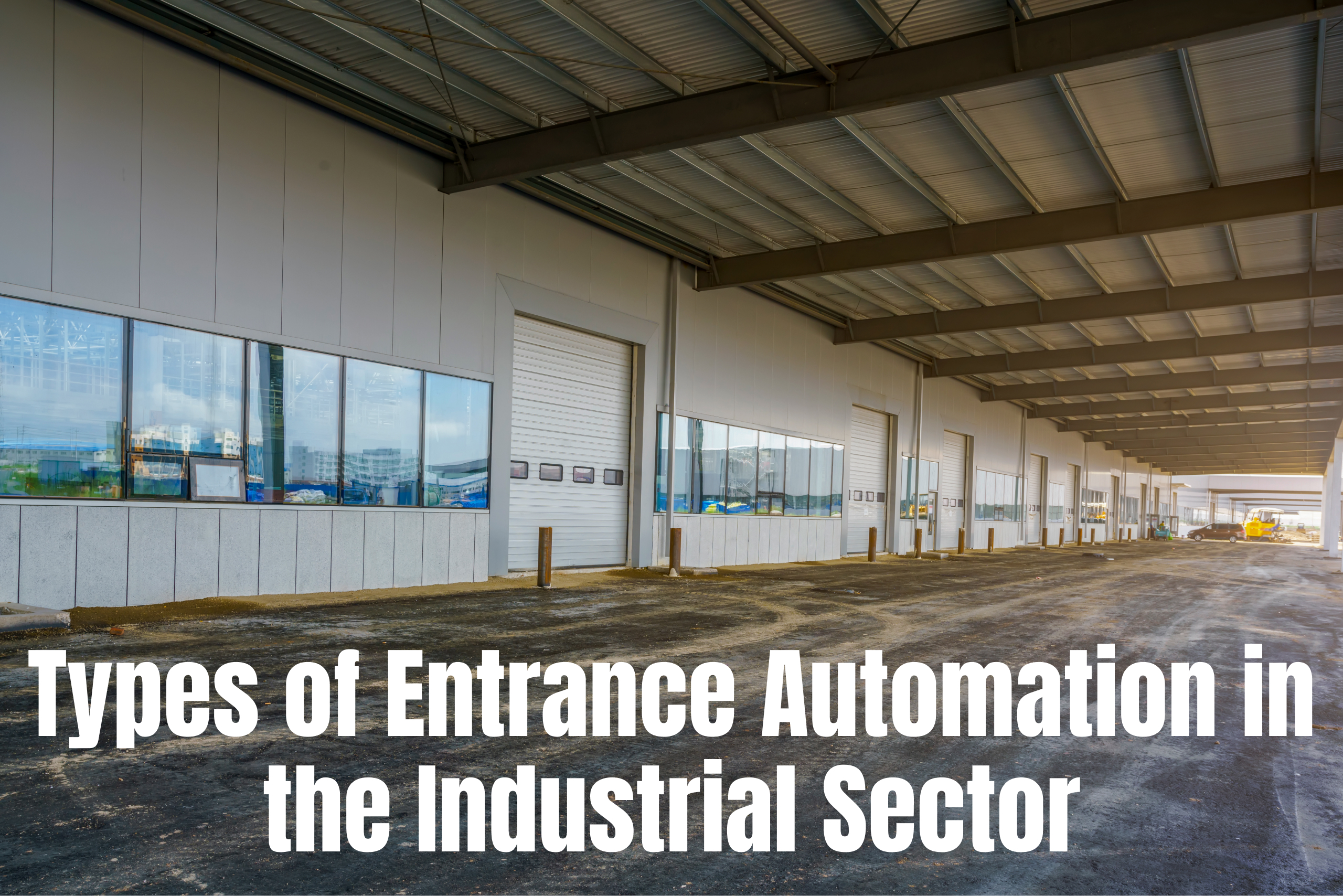Technologies are making at least one type, if not more, easier to work with in many ways in this fast-changing industrial world. One area of major change has been how people and vehicles enter factories, warehouses, and other industrial buildings. All of this is made possible through entrance automation. Entrance automation refers to the use of smart technology to open and shut doors, gates, and barriers without the need for a person to physically contact and open or close them. With millions of credentials to unlock, this could translate into safer, faster, and more efficient access control for the industrial sector.
This post is going to discuss the various kinds of entrance automation used in the industrial domain. In this article, we will discuss the way these systems work, why they are important, and how they can help businesses save costs as well as keep data secure. Read on to find out more if you are a business owner or are simply interested in what the future holds for industrial automation!
Different Kinds of Entrance Automation Systems
Automatic Gates
Gate automation is one of the most well-known types of entrance automation in warehouses and factories. It opens and closes automatically as a vehicle or person approaches. These come with sensors or remote-control technology that ensure a seamless operation of the gate and its closure.
How It Works: When the vehicle or person comes to the entrance, the sensor will sense it and send a message to the gate to open. When the vehicle passes, the gate closes automatically.
Benefits:
Enhanced Security: Controlled access minimizes the risk of unsolicited guests.
Improved Efficiency: Cars can instead go through unmanned checkpoints without having to stop, allowing for expanded and further enhanced traffic flow.
EXAMPLE: In high-traffic warehouses, automatic gates enable delivery trucks to enter and exit the premises without delay, cutting down on congestion and freeing up time for workers inside.
A perfect illustration of how industrial automation can improve operations, enhancing safety and efficiency while increasing warehouse throughput, is automation of this type.
Automated Doors
Selecting automated doors is another well-liked industry product. These doors utilize motion sensors, timers, or even pressure plates to detect a body when someone is close enough and adjust to open automatically.
How it works: Sensors are placed at the front near the door to detect movement and activate the door to open. The door automatically closes after a preset time.
Benefits:
Improved Hygiene: As the doors are operated without contact, they help reduce the spread of germs, a particularly important benefit in crowded areas.
Energy Savings: Automated doors minimize the time the door remains open, conserving indoor temperatures and combating excessive heating or cooling costs.
Easy to Use: It is very useful when employees carry heavy loads.
Automated doors are a part of larger access control systems that benefit both by facilitating access and protecting industrial entrance systems designed to cater to large volumes.
Biometric Entrance Systems
Biometric entrance systems employ biological characteristics unique to each individual, including fingerprint, facial, or iris recognition. Entrance automation like this is vital to many industries that rely heavily on security, like warehouses.
How It Works: Employees or authorized visitors scan a fingerprint or a face at a dedicated device. By quickly confirming their identity, they are allowed access.
Benefits:
High Security: The biometric data of each individual is unique, which means that entrance can only be given to authorized individuals.
Audit Trails: Each access can be logged by the system, enabling tracking of who enters or exits the facility.
Minimized Fraud: As biometric information is incredibly challenging to imitate, this system offers a high degree of security from unauthorized access.
Biometrics provides a way to automate entrance in the facility, thus offering enhanced access control in industrial environments.
RFID-Based Systems
Industrial entrance automation has seen a large impact with the deployment of RFID (Radio Frequency Identification) systems for access monitoring and control. Employees, vehicles, or assets are assigned an RFID tag, and readers at the entrance automatically scan them.
How It Works: An RFID reader on a gate detects an RFID tag as an employee or vehicle approaches. It then verifies that the tag is valid and, if so, opens the gate.
Benefits:
Fast & Efficient: This is a very quick process, making it very well suited for industrial areas with high traffic.
Real-Time Monitoring: RFID systems can track who is entering and exiting the facility in real time.
Inventory Management: In some instances, these systems can also be utilized to track inventory in the warehouse.
A classical case of how industrial automation can be introduced in everyday operations as an enhancement to efficiency and security is the installation of an RFID-based access control system.
Remote Controlled Systems
Wireless technologies will be used in remote-controlled entrance systems via Bluetooth or Wi-Fi compatibility. They are especially useful for industrial sectors where entrances are diffused over extensive surfaces.
How This Works: The authorized user remotely opens the gate or door using a smartphone or dedicated remote control.
Benefits:
Flexibility: Users can open/close the entrance from anywhere.
Emergency Response: In emergencies, remote control can be used to quickly lock down a facility.
User-Friendly: These systems are made for individuals who don’t need extensive training.
Remote-controlled systems are a part of entrance automation that increases the overall efficiency and flexibility of the industrial entrance systems.
Integrated Security Systems
Integrated security systems This is a combination of all entrance automation solutions in a single interface. Such systems combine automatic gates, automated doors, biometric sensors, RFID, and remote controls with video surveillance and alarm systems.
How It Works: Various technologies are connected to an internal control unit that grants or denies access based on predetermined criteria. This unit communicates with each of its parts and provides a full picture of the entrance environment.
Benefits:
Layered Approach: Multiple security features in tandem allow access only when authorized.
Centralized Management Optimizes the process of monitoring and maintenance as facilities can be managed from a single control room.
Scalable: Integrated systems offer the option to scale up or upgrade as the facility expands.
Integrated Systems Integrated systems represent the epitome of industrial automation and access control with the best-in-class access management solution.
So How Entrance Automation Can Help Warehouses
Picture a bustling warehouse with delivery trucks coming in and out constantly. Prior to the entrance automation, a security guard needed to open the gate manually for each truck. The process commonly resulted in long lines, wasted time, and, occasionally, a breach of security if the guard overlooked an individual. In entrance automation, sensors detect when a truck enters or exits, and automatic gates allow the vehicle to pass without having to wait. This accelerates the process and minimizes the risk of unwanted access, allowing only verified vehicles to enter the warehouse. One example of this would be how entrance automation helps with the overall efficiency and security in a warehouse environment.
Cost Advantages of Choosing Entrance Automation
How entrance automation can prove to be a cost-effective investment for industrial facilities Investing in entrance automation is a smart and cost-effective investment for industrial facilities for a number of reasons.
Lower Labor Costs: Automated systems need less human involvement. Fewer security personnel will be required to oversee entry and exit points, to the extent that this can ultimately result in notable labor cost savings.
Reduced Maintenance Costs: Automatic gates and doors are designed for longevity, requiring less upkeep than manual alternatives. They tend to have longer lifespans and need fewer repairs, which can help keep those ongoing maintenance costs down.
Improved Operational Efficiency: Automating the entrance process lessens delays and crowding at the entrance. This is especially cost-effective in the sense that warehouses and industrial sites can perform at a better capacity, thus having more productivity, which can eventually lead to more revenue.
Increased Security Significant security improvements lead to reduced theft and unauthorized access losses. That can translate to lower insurance premiums and fewer losses, enhancing financial performance further still.
Energy Savings: By reducing the amount of time any door stays open, automated doors are better at preserving climate control within your building. This can lower your costs for both the heating and cooling of the home, helping you save energy overall.
Scalability and Future Proofing: With the continued growth of industrial facilities, the scalability of automated systems allows for the entrance system to be enhanced or extended as needed without a major added cost. This future-proofing safeguards the initial investment and enhances long-term financial planning.
While the initial expense for entrance automation can be steep compared to traditional, manual solutions, over their lifetime the total cost of ownership—spanning lower labor and maintenance costs, improved operational efficiency, and lower energy use—means they are financially worth every penny for industrial facilities.
Conclusion
Entrance automation has come a long way in the industrial sector since its conception. Several types of industrial entrance systems are available, including automatic gates and automated doors—as well as advanced biometric and RFID systems—designed to enhance safety, efficiency, and cost-effectiveness. At the same time, these systems also save notable money in labor, maintenance, and efficiency.
The case for entrance automation in warehousing and industrial environments is undeniable: increased throughput, improved security, and cost savings over time mean that automated entrance systems are a critical element in today’s automated industrial landscape. With the rapid advancements in technology, incorporating these creative solutions will be crucial for businesses to stay relevant in a world that is becoming more and more reliant on automation.
Automation and smart entrance technologies are no longer things of the future—they are here to stay, and this is only the start—the industrial revolution is next.



